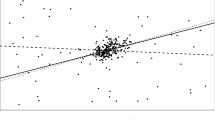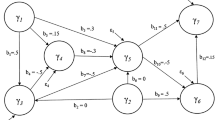Abstract
With the advent of consistent partial least squares (PLSc), an interest has surged in comparing the quality of various estimation methods in structural equation models. Of particular interest are, beside PLSc, Bentler’s non-iterative confirmatory factor analysis, Hägglund’s instrumental variable (IV) estimation method, and Ihara–Kano’s non-iterative uniqueness estimation method. All of these methods yield consistent estimates of parameters in measurement models (factor loadings and unique variances), but require additional steps to estimate parameters in structural models [covariances among latent variables (LVs) and path coefficients]. These additional steps typically involve calculating LV scores, either correlating them or applying regression analysis, and correcting possible “biases” incurred by the use of LV scores as proxies of true LVs. In this paper, we conduct a Monte Carlo study to evaluate parameter recovery capabilities of the above LV extraction methods in conjunction with subsequent LV score construction and bias correction methods. We also compare these methods against more conventional estimation methods, such as the full least squares and maximum likelihood methods, that estimate parameters in both measurement and structural models simultaneously. In addition, we examine three methods of estimating standard errors (SEs) of estimated parameters from a single data set, the bootstrap method, ordinary least squares regression, and the inverse Hessian method. The SEs are important in assessing the reliability of parameter estimates and in testing their significance. It was found that Hägglund’s method used to extract one LV at a time from each block of observed variables, combined with Croon’s bias correction method, worked best in both parameter recovery and resistance to improper solutions, and that the bootstrap method provided the most accurate estimates of SEs.
Similar content being viewed by others
References
Bentler PM (1982) Confirmatory factor analysis via noniterative estimation: a fast, inexpensive method. J Mark Res 19:417–424
Bollen KA (1996) An alternative two stage least squares (2SLS) estimator for latent variable equations. Psychometrika 61:109–121
Croon M (2002) Using predicted latent scores in general latent structure models. In: Marcoulides GA, Moustaki I (eds) Latent variable and latent structure models. Lawrence Earlbaum Associates, Mahwah, pp 195–223
Cudeck R, Klebe KJ, Henly SJ (1993) A simple Gauss–Newton procedure for covariance structure analysis with high-level computer languages. Psychometrika 58:211–232
Devlieger I, Mayer A, Rosseel Y (2015) Hypothesis testing using factor score regression: a comparison of four methods. Educ Psychol Meas 75:1–30
Dijkstra TK (2013) The simplest possible factor model estimator. Unpublished note, University of Groningen
Dijkstra TK (2016) A note on how to make partial least squares consistent. Unpublished note, University of Groningn
Dijkstra TK, Schermelleh-Engel K (2014) Consistent partial least squares for nonlinear structural equation models. Psychometrika 79:585–604
Efron B (1979) Bootstrap methods: another look at the jackknife. Ann Stat 7:1–26
Hägglund G (1982) Factor analysis by instrumental variables methods. Psychometrika 47:209–222
Ihara M, Kano Y (1986) A new estimator of the uniqueness in factor analysis. Psychometrika 51:563–566
Jöreskog KG (1977) Factor analysis by least-squares and maximum likelihood methods. In: Enslein K, Ralston A, Wilf HS (eds) Statistical methods for digital computers. Wiley-Interscience, New york, pp 125–153
Jung S, Takane Y (2008) Regularized common factor analysis. In: Shigemasu K, Okada A, Imaizumi T, Hoshino T (eds) New trends in psychometrics. University Academic Press, Tokyo, pp 141–149
Lu IRR, Kwan E, Thomas DR, Cedzynski M (2011) Two new methods fr estimating structural equation models: an illustration and a comparison with two established methods. Int J Res Mark 28:258–268
McDonald RP, Burr EJ (1967) A comparison of four methods of constructing factor scores. Psychometrika 32:381–401
Skrondal A, Laake P (2001) Regression among factor scores. Psychometrika 66:563–576
Skrondal A, Rabe-Hesketh S (2004) Generalized latent variables modeling. Chapman-Hall/CRC Press, Boca Raton
Acknowledgements
The work reported in this paper has been supported by research grants from the Natural Sciences and Engineering Research Council of Canada to both authors.
Author information
Authors and Affiliations
Corresponding author
Ethics declarations
Conflict of interest
On behalf of all authors, the corresponding author states that there is no conflict of interest.
Additional information
Communicated by: Wolfgang Wiedermann.
About this article
Cite this article
Takane, Y., Hwang, H. Comparisons among several consistent estimators of structural equation models. Behaviormetrika 45, 157–188 (2018). https://doi.org/10.1007/s41237-017-0045-5
Received:
Accepted:
Published:
Issue Date:
DOI: https://doi.org/10.1007/s41237-017-0045-5
Keywords
- Bentler’s non-iterative confirmatory factor analysis
- Hägglund’s instrumental variable (IV) estimation method
- Ihara–Kano’s non-iterative uniqueness estimation method
- Latent variable (LV) scores
- Croon’s bias correction method
- Skrondal–Laake’s method
- Consistent partial least squares (PLSc)
- Blockwise and full least squares and maximum likelihood methods
- Bollen’s two-stage least squares (2SLS) method
- The bootstrap method
- Ordinary least squares (OLS)
- The inverse Hessian method




